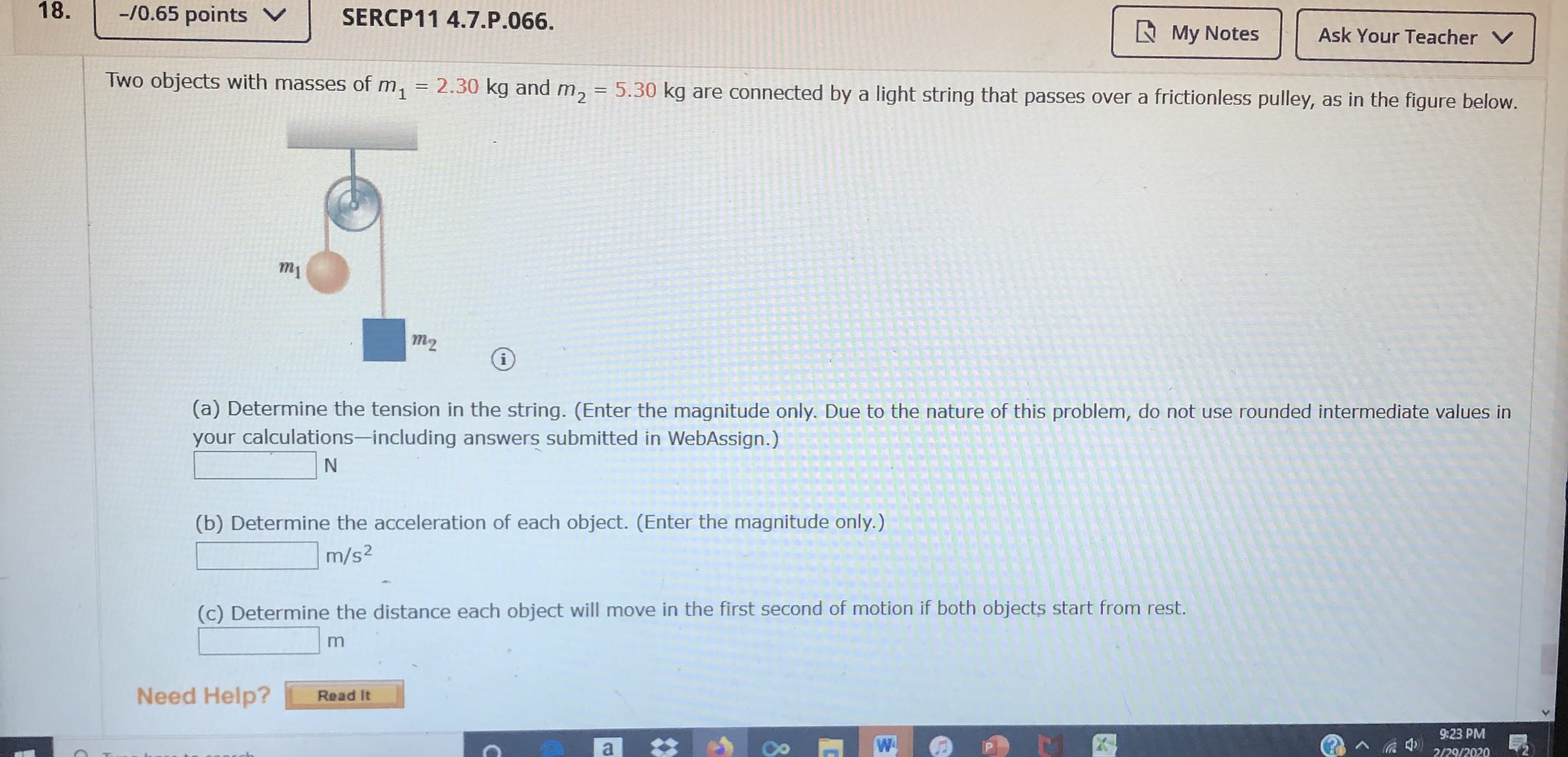18. -/0.65 points V SERCP11 4.7.P.066. A My Notes Ask Your Teacher V Two objects with masses of m, = 2.30 kg and m, = 5.30 kg are connected by a light string that passes over a frictionless pulley, as in the figure below. m1 m2 (a) Determine the tension in the string. (Enter the magnitude only. Due to the nature of this problem, do not use rounded intermediate values in your calculations-including answers submitted in WebAssign.) (b) Determine the acceleration of each object. (Enter the magnitude only.) m/s2 (c) Determine the distance each object will move in the first second of motion if both objects start from rest. Need Help? Read It 9:23 PM 2020ו229 8.
18. -/0.65 points V SERCP11 4.7.P.066. A My Notes Ask Your Teacher V Two objects with masses of m, = 2.30 kg and m, = 5.30 kg are connected by a light string that passes over a frictionless pulley, as in the figure below. m1 m2 (a) Determine the tension in the string. (Enter the magnitude only. Due to the nature of this problem, do not use rounded intermediate values in your calculations-including answers submitted in WebAssign.) (b) Determine the acceleration of each object. (Enter the magnitude only.) m/s2 (c) Determine the distance each object will move in the first second of motion if both objects start from rest. Need Help? Read It 9:23 PM 2020ו229 8.
Physics for Scientists and Engineers, Technology Update (No access codes included)
9th Edition
ISBN:9781305116399
Author:Raymond A. Serway, John W. Jewett
Publisher:Raymond A. Serway, John W. Jewett
Chapter5: The Laws Of Motion
Section: Chapter Questions
Problem 5.84AP
Related questions
Question
This hasn't been graded as you can see there's no red. just need some help with the steps please thanks.

Transcribed Image Text:18.
-/0.65 points V
SERCP11 4.7.P.066.
A My Notes
Ask Your Teacher V
Two objects with masses of m, = 2.30 kg and m, = 5.30 kg are connected by a light string that passes over a frictionless pulley, as in the figure below.
m1
m2
(a) Determine the tension in the string. (Enter the magnitude only. Due to the nature of this problem, do not use rounded intermediate values in
your calculations-including answers submitted in WebAssign.)
(b) Determine the acceleration of each object. (Enter the magnitude only.)
m/s2
(c) Determine the distance each object will move in the first second of motion if both objects start from rest.
Need Help?
Read It
9:23 PM
2020ו229
8.
Expert Solution
This question has been solved!
Explore an expertly crafted, step-by-step solution for a thorough understanding of key concepts.
This is a popular solution!
Trending now
This is a popular solution!
Step by step
Solved in 6 steps with 6 images

Knowledge Booster
Learn more about
Need a deep-dive on the concept behind this application? Look no further. Learn more about this topic, physics and related others by exploring similar questions and additional content below.Recommended textbooks for you

Physics for Scientists and Engineers, Technology …
Physics
ISBN:
9781305116399
Author:
Raymond A. Serway, John W. Jewett
Publisher:
Cengage Learning

College Physics
Physics
ISBN:
9781938168000
Author:
Paul Peter Urone, Roger Hinrichs
Publisher:
OpenStax College

College Physics
Physics
ISBN:
9781285737027
Author:
Raymond A. Serway, Chris Vuille
Publisher:
Cengage Learning

Physics for Scientists and Engineers, Technology …
Physics
ISBN:
9781305116399
Author:
Raymond A. Serway, John W. Jewett
Publisher:
Cengage Learning

College Physics
Physics
ISBN:
9781938168000
Author:
Paul Peter Urone, Roger Hinrichs
Publisher:
OpenStax College

College Physics
Physics
ISBN:
9781285737027
Author:
Raymond A. Serway, Chris Vuille
Publisher:
Cengage Learning

Physics for Scientists and Engineers with Modern …
Physics
ISBN:
9781337553292
Author:
Raymond A. Serway, John W. Jewett
Publisher:
Cengage Learning

Principles of Physics: A Calculus-Based Text
Physics
ISBN:
9781133104261
Author:
Raymond A. Serway, John W. Jewett
Publisher:
Cengage Learning

Physics for Scientists and Engineers
Physics
ISBN:
9781337553278
Author:
Raymond A. Serway, John W. Jewett
Publisher:
Cengage Learning